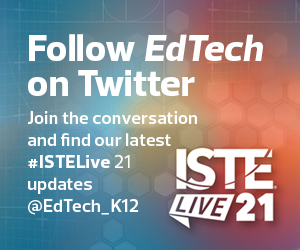That dream team should include a cross section of representatives from administration, finance, trustees and governors, special education, network management and administration, senior leadership, training and others — and at the heart of that team should be teachers and students.
Confident Educators Use Ed Tech Tools Consistently
When it comes to getting educators to consistently use ed tech tools, Kingsley said, “confidence is king.”
He stressed that consistent, ongoing training of educators was key to helping schools quickly adapt and use ed tech tools. One way to do this, he said, is to identify “flag bearers” — those early adopters who are excited about tech and who are willing to teach their colleagues. Some districts have ed tech clubs where colleagues share what they’ve learned with each other, he said.
For those concerned about the amount of time in-person training would require, he recommended creating online resources and documentation that staff could access on their own schedule.
He also shared Canadian teacher and ed tech consultant Sylvia Duckworth’s illustration of “The 4 Stages of Teacher Confidence in the Use of Technology,” which uses the SAMR model of substitution, augmentation, modification and redefinition. SAMR depicts increased confidence in technology use, starting with phase 1, where the teacher is shown drowning and trying to survive, then moving up the mountain to phase 4, where the teacher exhibits digital literacy and innovation.
MORE FROM EDTECH: Learn more about the new tools supporting teachers’ return to the classroom.
Communication as the Foundation of Digital Strategy
Kingsley pointed out that due to rapid deployment of solutions from Microsoft and Google, teachers are no longer siloed all day in their classrooms and are now participating in communication that’s greater and different than before.
Without communication as its foundation, a district’s digital strategy is essentially ineffective, Kingsley said. He noted that, in years past, communication was often an afterthought.
However, he believes that in this age of increased technological integration, it is important to have greater communication between leadership and staff, between schools and students, and between schools and parents. Appropriate communication about the right technology can not only save time and other resources but also can ensure students’ well-being, especially those with special needs.
Technology Redefines the Previously Inconceivable
Kingsley shared that, even though some may have struggled to adapt to new technologies during the pandemic, technology allowed schools to accomplish things that were previously inconceivable. He encouraged attendees to think of these as building blocks and to embrace the positive outcomes as they returned to their classrooms in person. He noted that while synchronous and asynchronous learning may have been required at a particular point in time, it gave teachers skills that they can build upon moving forward. Prerecorded video, in particular, can allow students to study for exams, providing flexibility for both the teacher and the students.
Another benefit: Monitoring tools can allow schools to appropriately address students’ worrisome online behaviors sooner.
DISCOVER: AI-powered content filtering adds new protection powers.
Kingsley also encouraged districts to seek evidence of a tool’s effectiveness from research and case studies, and recommended that they ask vendors for a trial period before committing to purchase of any product.
Ed Tech Is Not the Primary Solution
Kingsley also discussed the need for each district to have its own unique vision. He encouraged districts to use their strengths and skills to inform their vision.
“Here’s the shocker: Ed tech is not the solution,” Kingsley emphasized before adding that technology has “the ability to support and empower those key strands of teaching, pedagogy, communication, well-being and engagement. … There’s plenty of research that shows that where it is used appropriately and effectively, it can empower teachers and students to greater levels.”
Districts will know that their digital strategy is effective when it is “not a part of the daily discussion, but is an integral part of the school day. It’s discussed when appropriate but not forced into each and every setting. When teachers have confidence in the tools to try something different, middle leaders are empowered to innovate with technology, and IT managers at the heart of digital discussion are informed of the outcomes and students become confident digital citizens.”
Join EdTech as we provide written and video coverage of ISTELive 21. Bookmark this page and follow us on Twitter @EdTech_K12.











